- Paragraph Generator
- Cover Letter
- Authorization Letter
- Application Letter
- Letter of Intent
- Letter of Recommendation
- Business Plan
- Incident Report
- Reference Letter
- Minutes of Meeting
- Letter of Resignation
- Excuse Letter
- Research Proposal
- Job Application
- Acknowledgement
- Employment Letter
- Promissory Note
- Business Proposal
- Statement of Purpose
- Offer Letter
- Deed of Sale
- Letter of Interest
- Power of Attorney
- Solicitation Letter

School Business Plan
School business plan format, school business plan samples, what is a school business plan, benefits of a school business plan, how to create a school business plan, why are the mission statement and vision statement important, what is the use of school business plan, how long should a school business plan be, what financial details should a school business plan include, what role does branding play in a school business plan, can a school business plan be used for funding, can a school business plan be modified after implementation.
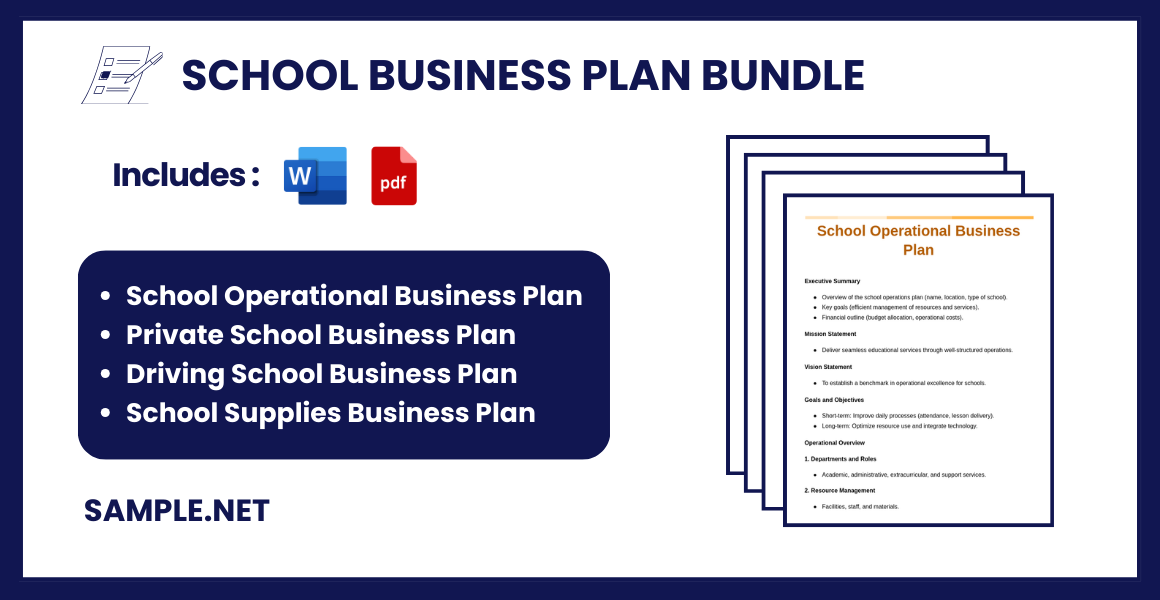
Executive Summary
- Brief description of the school (name, location, mission, and vision).
- Key objectives of the school (educational goals, community impact).
- Financial overview (funding requirements, expected profitability).
Mission Statement
- Define the core mission and values of the school.
- Highlight what sets the school apart (unique educational philosophy, specialized programs).
Vision Statement
- Long-term aspirations for the school (e.g., creating future leaders, contributing to community growth).
Goals and Objectives
- Short-term goals (e.g., enrollment targets, curriculum development).
- Long-term goals (e.g., school expansion, academic recognition).
School Overview
1. type of school.
- Private, public, charter, or specialty school (e.g., STEM-focused, arts-based).
2. Target Audience
- Grade levels (e.g., K-12, elementary).
- Demographics (local community, international students, underserved populations).
3. Location
- Description of the school’s location and benefits of the chosen area.
4. Legal Structure
- Ownership (individual, partnership, organization).
- Registration and licensing details.
Market Analysis
1. industry overview.
- Trends in education (e.g., increasing demand for specialized education).
- Current market challenges and opportunities.
2. Target Market
- Define the ideal student demographic.
- Describe community needs and how the school will address them.
3. Competitor Analysis
- Identify competitors (local schools).
- Explain how your school differs (curriculum, extracurriculars, teaching methods).
Marketing and Admissions Plan
1. branding.
- Logo, tagline, and visual identity.
2. Advertising Channels
- Online marketing (website, social media).
- Traditional marketing (flyers, local events, radio ads).
3. Enrollment Process
- Application requirements, deadlines, and selection criteria.
4. Outreach
- Community engagement, partnerships with local organizations.
Operational Plan
1. curriculum development.
- Overview of the subjects and teaching methodologies.
- Accreditation details.
2. Staffing Plan
- Number of teachers and administrative staff.
- Qualifications and roles.
3. Facility Requirements
- Classroom sizes, technology, and safety measures.
4. Daily Operations
- School calendar, hours of operation, and policies.
Financial Plan
1. startup costs.
- Facility rental/purchase.
- Equipment, supplies, and initial staff salaries.
2. Revenue Streams
- Tuition fees, donations, grants, and sponsorships.
- Detailed income and expense projections for the first 3-5 years.
4. Break-Even Analysis
- Timeframe to achieve profitability.
5. Funding Requirements
- Amount of funding required and proposed use of funds.
6. Financial Risks
- Potential risks and mitigation strategies.
Governance and Leadership
1. board of directors.
- List of members, roles, and expertise.
2. Management Team
- Principal, administrators, and department heads.
3. Advisory Board
- Educational experts, community leaders, and investors.
- Detailed curriculum outline.
- Teacher and staff resumes.
- Facility blueprints or images.
- Supporting documents (licenses, market surveys, financial statements).
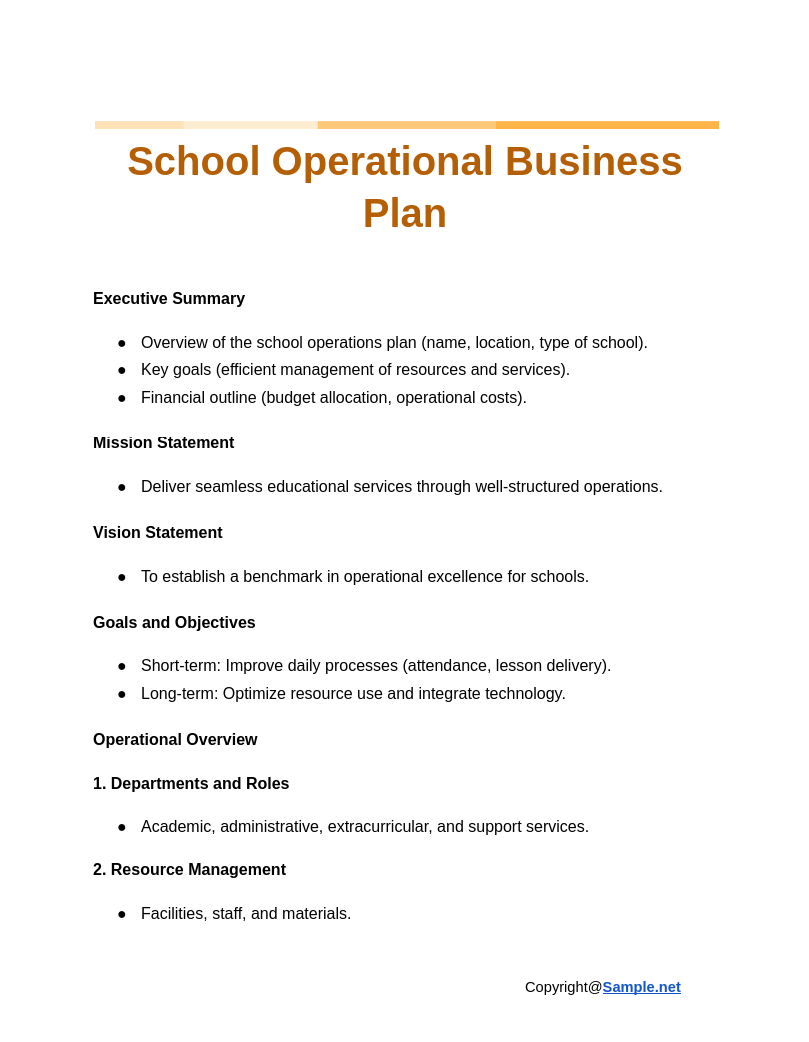
School Operational Business Plan
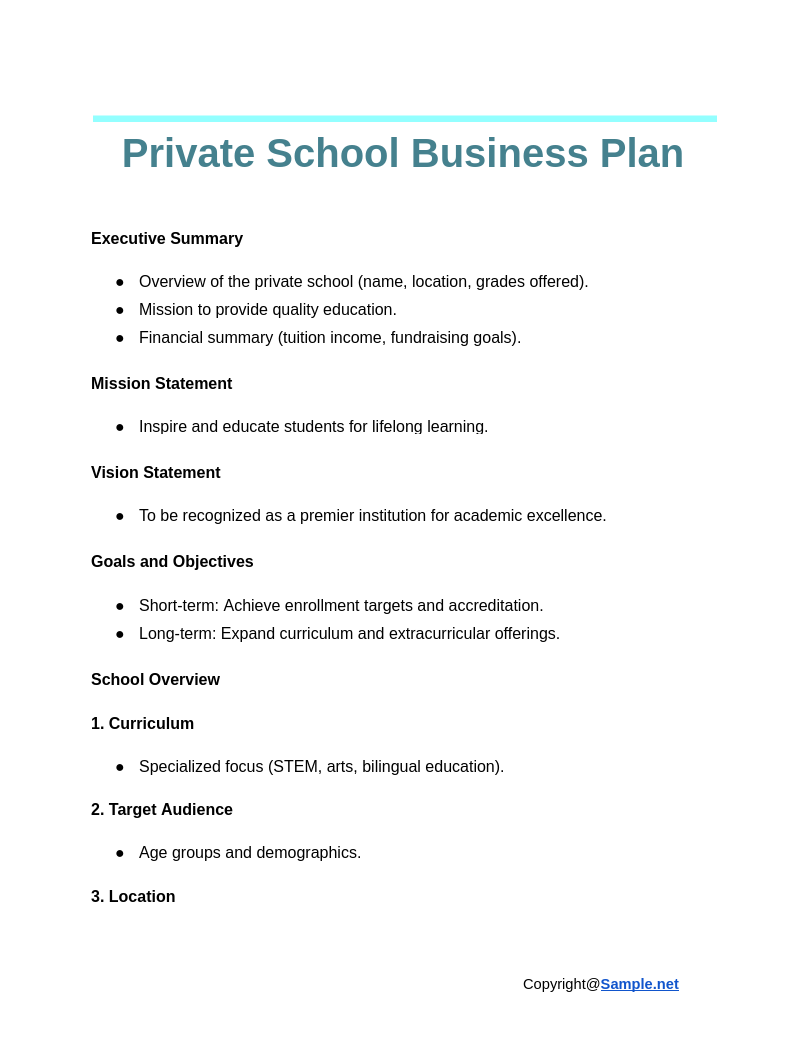
Private School Business Plan
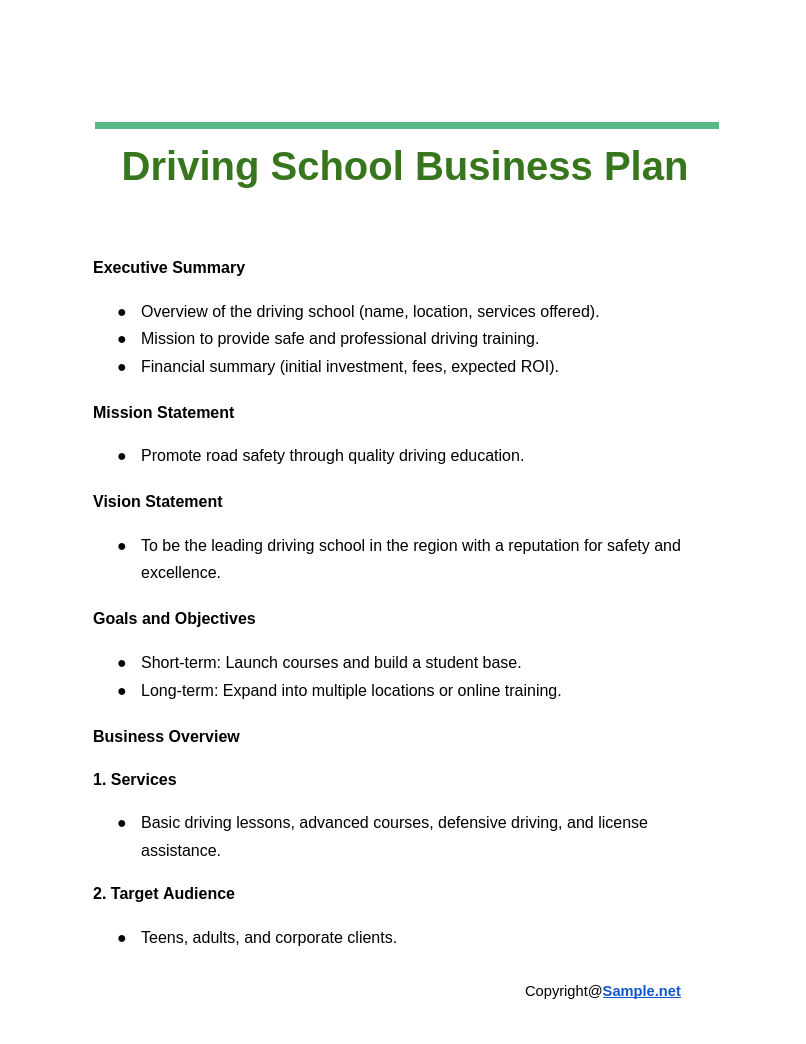
Driving School Business Plan
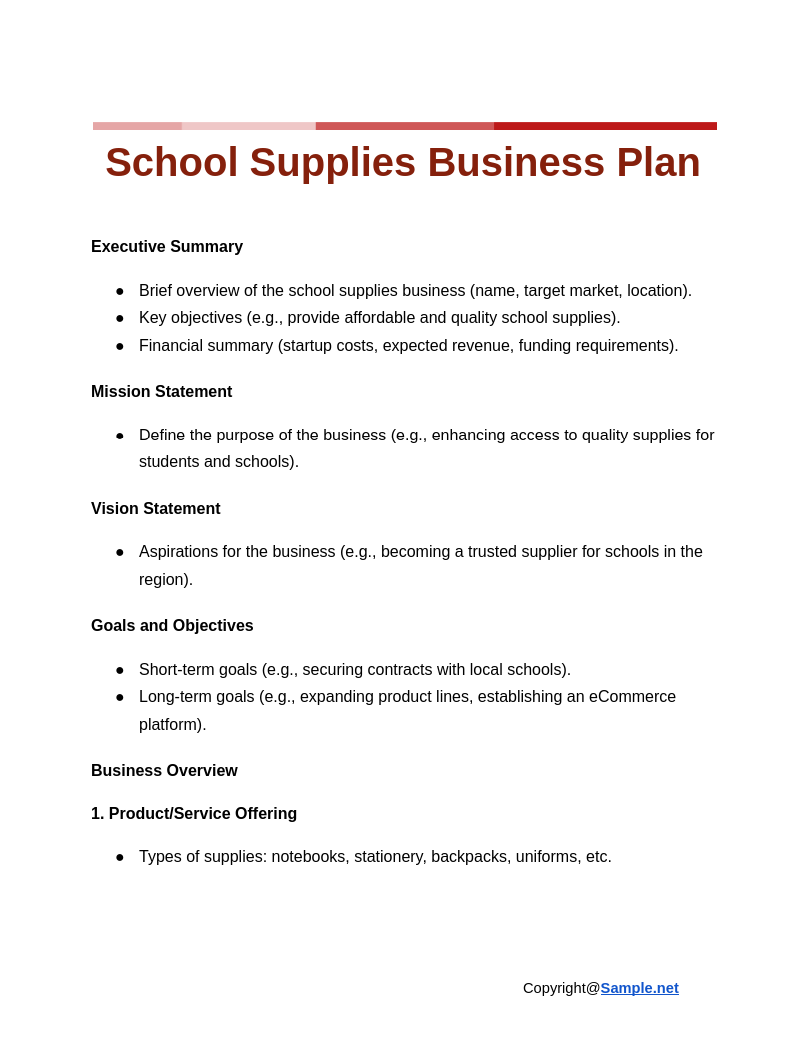
School Supplies Business Plan
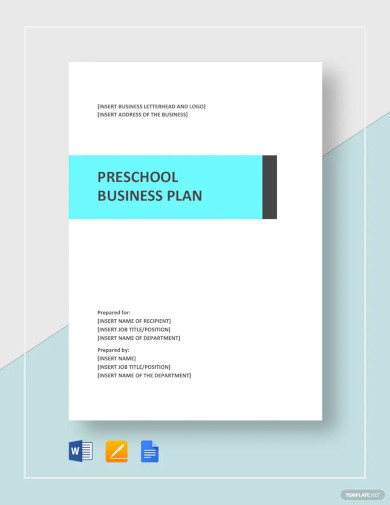
Preschool Business Plan Template
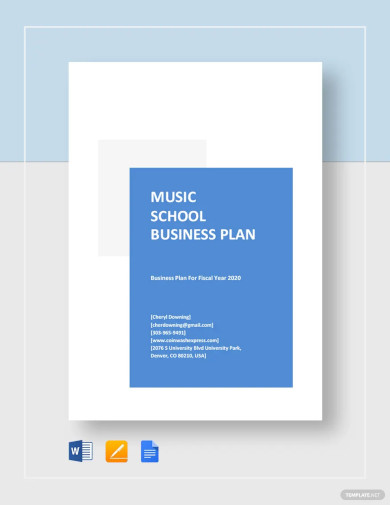
Music School Business Plan Template
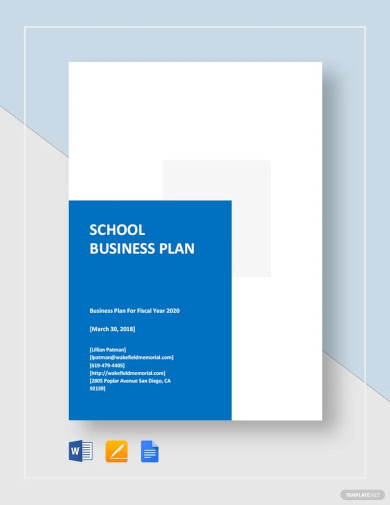
School Business Plan Template
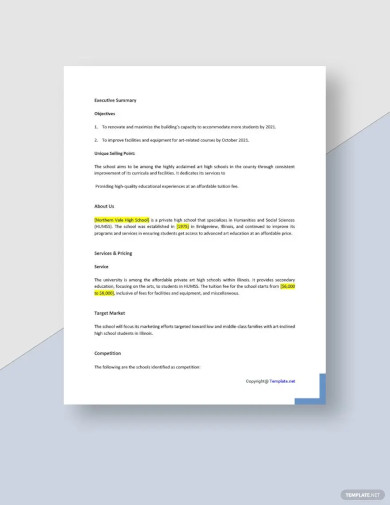
Free Basic School Business Plan Template

Bible School Business Plan Template
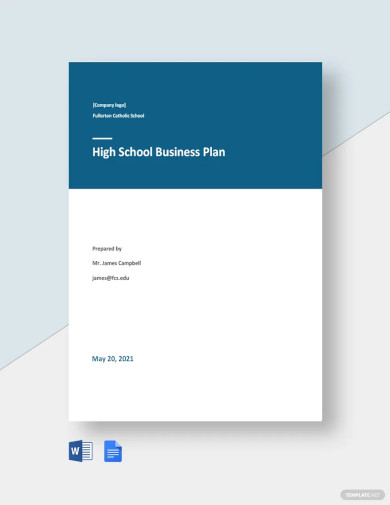
High School Business Plan Template

Middle School Business Plan Template
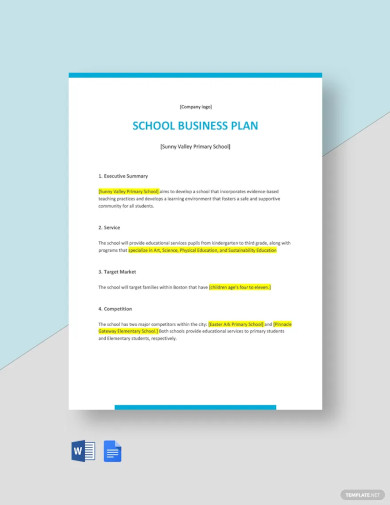
One Page School Business Plan Template
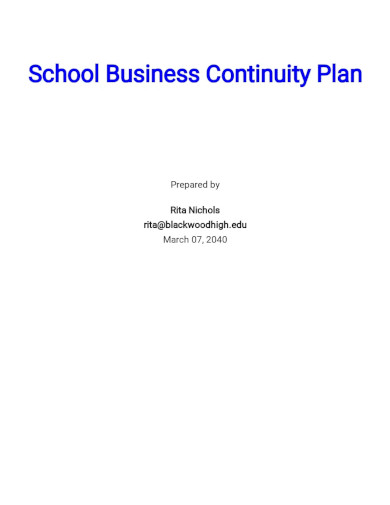
School Business Continuity Plan Template
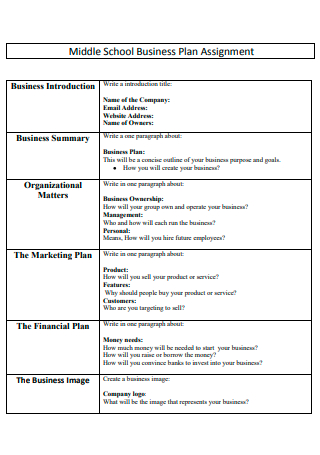
Middle School Business Plan Assignment

Sample Primary School Business Plan
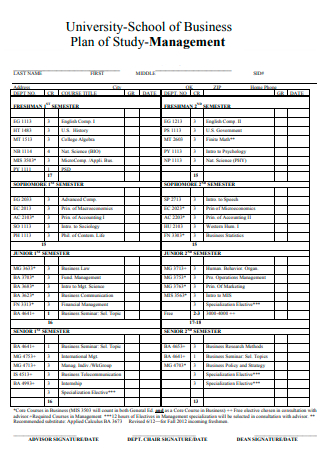
School Business Plan in PDF
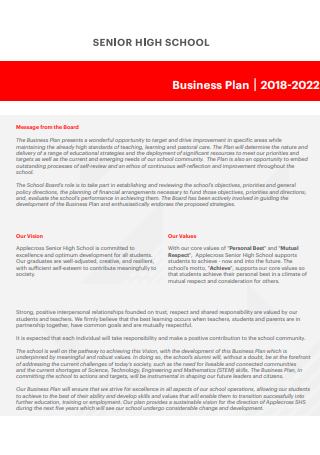
Senior High School Business Plan
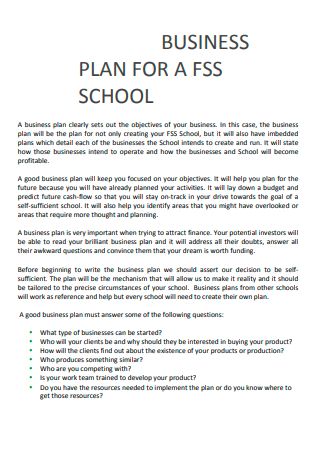
Non-Profit School Business Plan
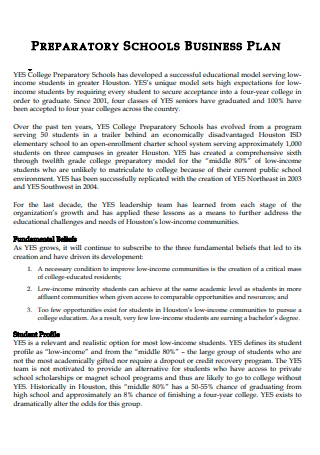
Sample Kindergarten School Business Plan
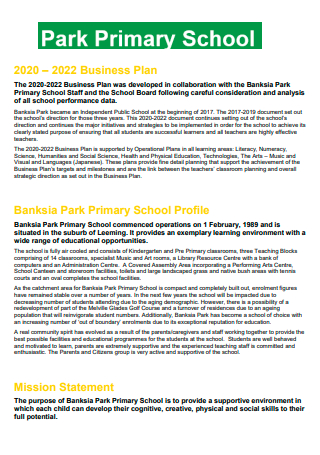
Park Primary School Business Plan
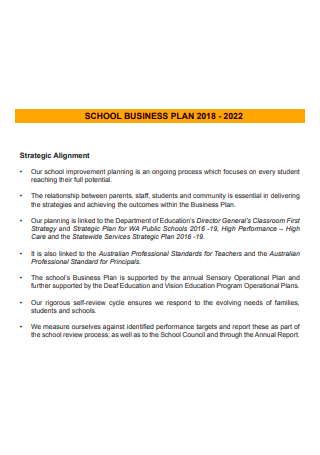
School Business Plan Executive Summary
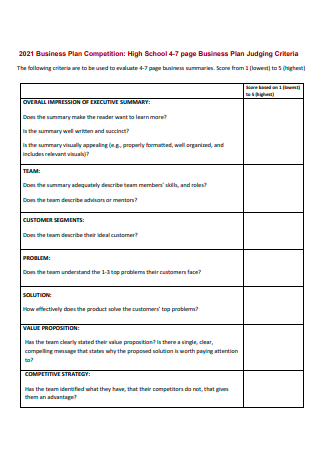
School Business Plan for Students


School Budget Business Plan
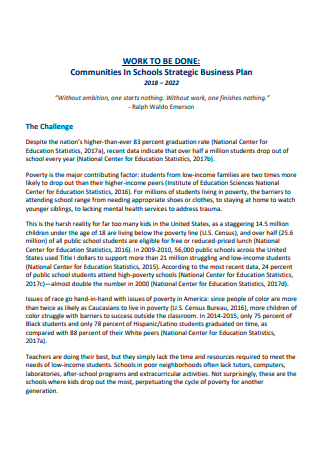
Sample School Funding Business Plan
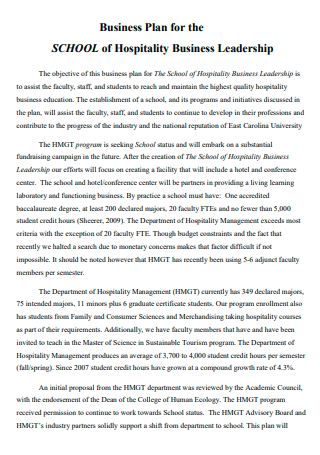
School Project Business Plan
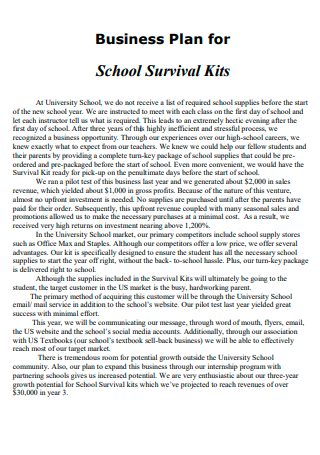
School Vocational Business Plan
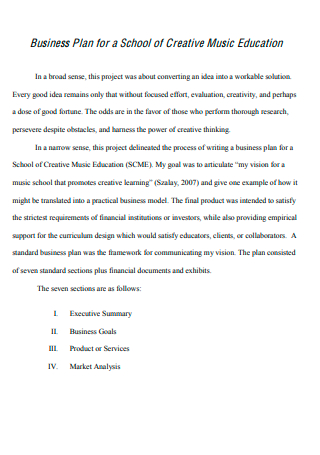
School of Creative Music Education Business Plan
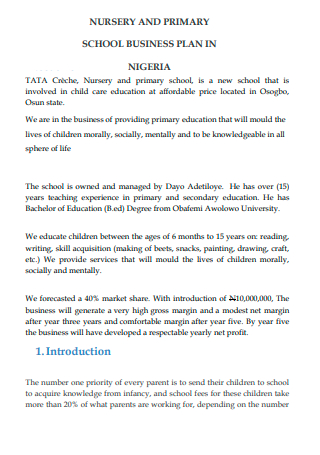
Nursery and Primary School Business Plan
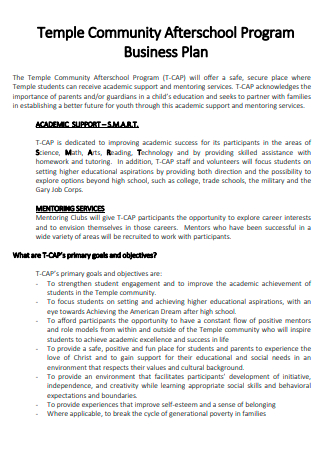
Temple Community After School Program Business Plan
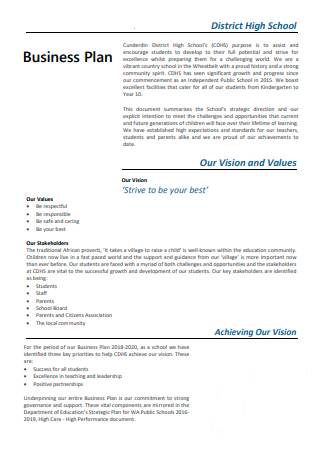
Sample Preschool Business Plan
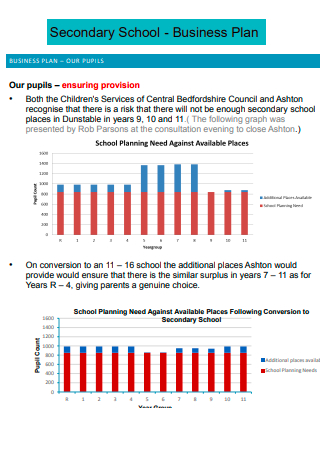
Secondary School Business Plan
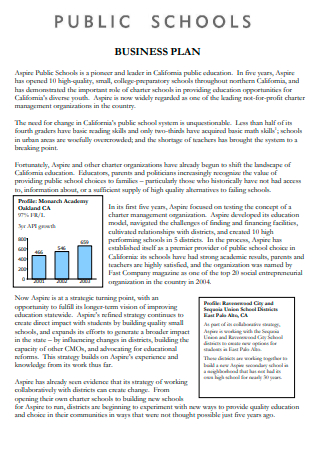
Public School Business Plan
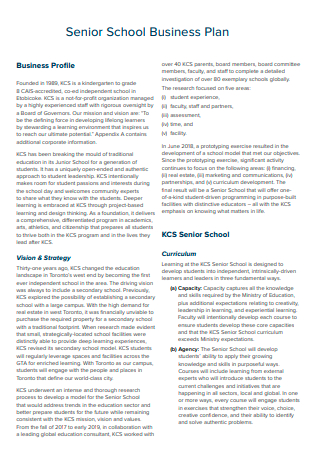
Sample Senior School Business Plan
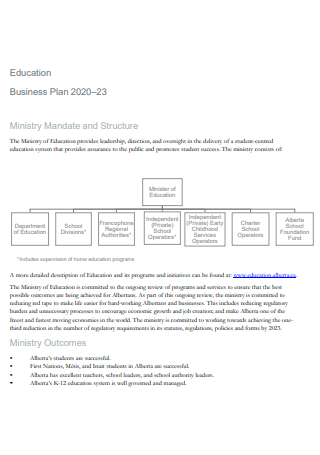
School Education Business Plan
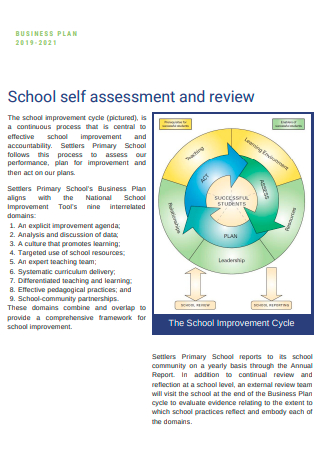
School Self Assessment and Review Business Plan
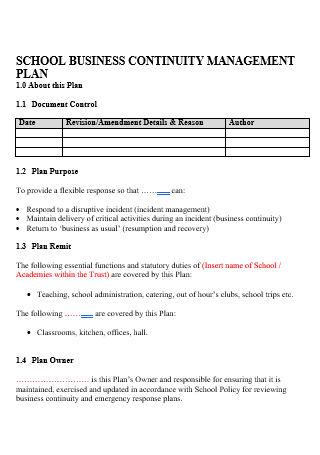
School Business Continuity Management Plan
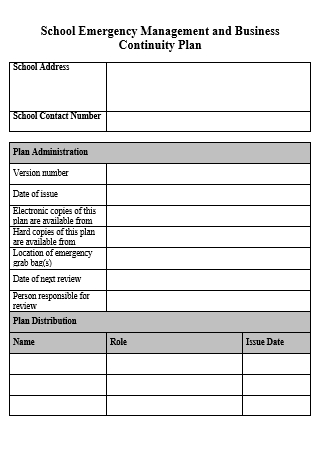
School Emergency Management and Business Continuity Plan

New School Business Plan
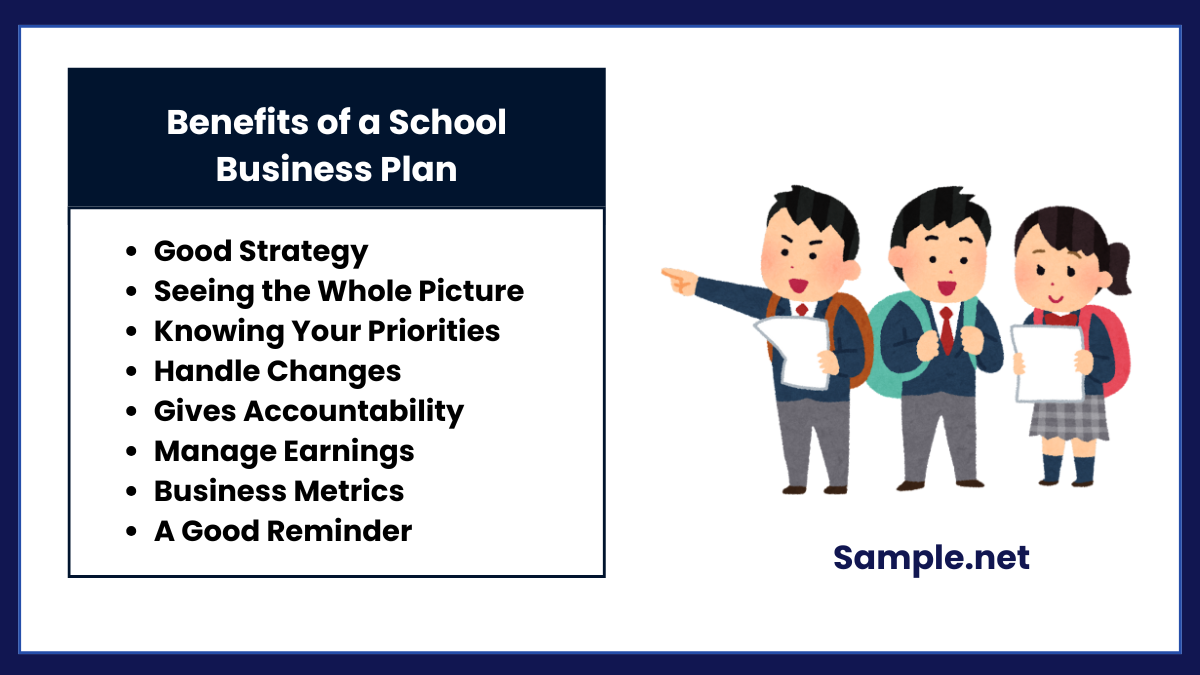
Step 1: Define the Vision and Mission
Step 2: conduct market research, step 3: develop the financial plan, step 4: outline the curriculum and services, step 5: create the marketing and operational strategies, share this post on your network, you may also like these articles, boutique business plan.
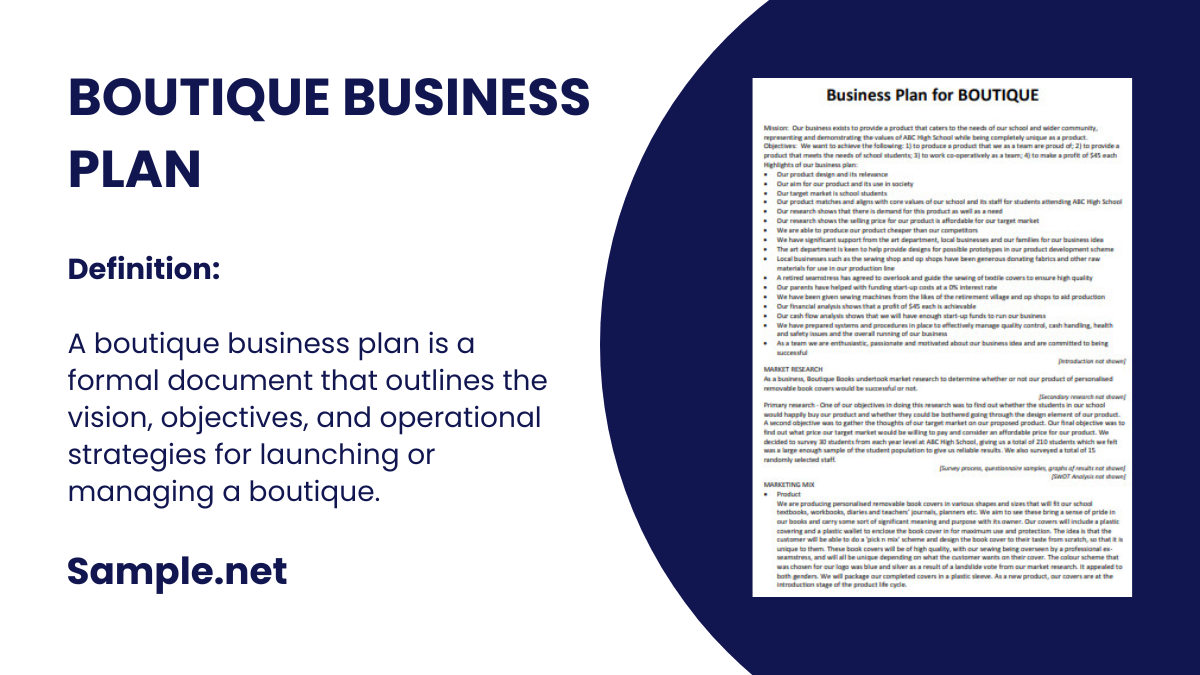
A boutique business plan is a comprehensive roadmap tailored to the unique needs of boutique owners. It outlines the business's goals, market strategies, and financial projections while capturing the…
Transportation Business Plan

Transportation plays a critical role in connecting businesses, communities, and markets. A well-structured transportation business plan ensures operational efficiency, cost-effectiveness, and scalability. Whether focusing on freight, passenger transit, or…
browse by categories
- Questionnaire
- Description
- Reconciliation
- Certificate
- Spreadsheet
Information
- privacy policy
- Terms & Conditions
School Business Plan Template
Written by Dave Lavinsky
School Business Plan
You’ve come to the right place to create your school business plan.
We have helped over 5,000 entrepreneurs and business owners create business plans and many have used them to start or grow their schools.
Sample Private School Business Plan
Below is a school business plan template to help you create each section of your own education business plan.
Executive Summary
Business overview.
Southside Academy, located in St. Paul, Minnesota, is a private school that has been providing quality education to the community’s school children since 2017. Southside Academy teaches elementary, middle school, and high school students in a wide range of subjects including mathematics, science, and history. We aim to provide a welcoming and inviting environment where every student can reach their highest potential.
We promote academic, artistic, and athletic excellence in a close-knit learning environment, with a challenging curriculum that cultivates intellectual curiosity. Furthermore, we offer a low teacher-to-child ratio, where teachers can build close connections with their students as they help them excel. We develop confident, continual learners by establishing behavioral supports and the social culture needed for students to achieve social, emotional, and academic success.
Service Offering
Southside Academy offers a premium private education at an affordable tuition fee. We provide a challenging education where students can explore their true potential and a safe space where they can freely discover and express themselves. Our students range from 1st grade to 12th grade and we teach a wide variety of subjects including:
- Basic Mathematics
- Physical Education
Customer Focus
Southside Academy primarily serves families within a 5-mile radius of the school’s location. The area is home to thousands of middle and upper-class families looking for high-quality education for their children. Before the school was built, the area was underserved and many children had to travel far to attend quality private schools.
Management Team
Southside Academy’s founder is Mike Brown who has been working as a teacher for more than 20 years. Mike has taught at several public schools in the region but saw a great demand for private education. He noticed that the current location of the school was underserved and set out to create a school to serve this population. Mike Brown has successfully led Southside Academy as its principal since the school’s inception and will continue to do so for the foreseeable future.
Mike Brown is supported by a team that has experience teaching students, managing finances, and running businesses. Specifically, our team has solid experience in being effective teachers, connecting to different types of students, and achieving key goals.
Success Factors
Southside Academy is able to achieve success by offering the following competitive advantages:
- Location: Southside Academy’s location is near the center of town, giving members of our community easy access for parents and their children.
- Passionate and Skillful Teachers: Southside Academy hires teachers with strong academic backgrounds who are skillful in handling all types of children.
- Low teacher-to-student ratio: We provide a low teacher-to-student ratio so that every student gets personal attention from teachers to reach their highest potential.
- Affordable, quality education: Most of the schools in the area offer their services at a very expensive price. Our fees will be moderately low so that good education is accessible to all families.
Financial Highlights
Southside Academy is currently seeking additional donations of $600,000 in order to fulfill our mission. The breakdown of the funding may be seen below:
- Salaries: $200,000
- School Materials (books, toys, desks, chairs, etc): $180,000
- Administrative Expenses: $120,000 to pay for lease costs, ongoing operational expenses, and marketing.
- Working capital: $100,000
The following graph below outlines the pro forma financial projections for Southside Academy.

Company Overview
Who is southside academy, southside academy’s history.
Southside Academy started as an idea from a group of school teachers, including Mike Brown. The teachers were university pals who are passionate about teaching and children. They have seen the gaps in education in St. Paul, Minnesota, and wanted to create a school that elevates the academic environment for the children of this area.
Their plans to build a school started in 2015, but it was only until April 2016 that they finally completed all the paperwork and met the legal requirements. Since then, Southside Academy has achieved the following milestones:
- Found a location and built the school
- Developed the school’s name, logo, and website
- Determined curriculum
- Hired teachers and other key employees
Southside Academy’s Services
Industry analysis.
Education is an essential foundation for a thriving society. It’s more important than ever before that every child has access to affordable, high-quality education. While public schools are an essential option for many low-income families, the education provided by private schools often results in higher test scores and more students moving on to top-tier universities.
The private school industry has experienced steady growth in the past five years. The key industry drivers are economic growth, the rise in numbers of K-12 students, an increase in the number of families with both parents working, and government initiatives to support education.
According to Polaris Market Research, this growth is expected to continue with a forecasted compound annual growth rate of 6.6% from now until 2030. This shows that Southside Academy has great potential to keep growing and expanding. We will have ample opportunities to grow our curriculum and offer services to students that help them reach their highest potential.
Customer Analysis
Demographic profile of target market.
Southside Academy serves the families and children of St. Paul, Minnesota. The area is mostly populated by young couples and new families that have disposable income and can pay a premium for their children’s education.
The precise demographics of the town in which our location resides are as follows:
Customer Segmentation
We primarily target the following three customer segments:
- Young children
- Young couples
Competitive Analysis
Direct and indirect competitors.
Southside Academy faces competition from other schools with similar profiles. A description of each competitor company is below.
Waters Independent School
Founded in 1968, Waters Independent School is a non-profit and tax-exempt independent school system. The school is governed by an independent Board of Trustees and offers preschool through eighth-grade programs. WIS is accredited by the state’s Council of Independent Schools (FCIS).
Waters Independent School has small class sizes with low student-to-teacher ratios. Further, WIS’ Programs include a strong academic foundation coupled with programs in the arts, physical education, media/technology, foreign language, and extracurricular areas.
Hill Preparatory School
Founded in 1923, Hill Preparatory School is a private, non-sectarian, coeducational, college preparatory day school. It offers PK-12 programs in a safe, student-centered environment. HPS supports its students through the challenges of the school year with one-on-one attention from dedicated faculty, robust services like The Learning Center and the College Center, and the most advanced educational technology. The campus spans 28 acres and has a new 60,000+ square foot facility.
Future Leaders Preparatory School
Founded in 1968, Future Leaders Prep is a private school for PreK3-8th grade. FLPS offers preschool, elementary school, and middle school programs and offers the International Baccalaureate program of study for all students. Teachers are endorsed in gifted education through a master’s level grant with [local University]’s College of Education Gifted Program. In addition to the school, Future Leaders offers community programs such as music, dance, art, and theater lessons through the Community School of the Arts, youth sports in the Community School for Sports, and the 7-week summer camp.
Competitive Advantage
There are many schools in St. Paul, Minnesota but none of them provides the same quality of education that Southside Academy provides, specifically the following:
Marketing Plan
Brand & value proposition.
The Southside Academy brand will focus on the school’s unique value proposition:
- Providing premium education at an affordable price
- Providing a supportive and challenging place for children to learn
- Giving parents the assurance that their children will reach their full potential
Promotions Strategy
The promotions strategy for Southside Academy is as follows:
Social Media
Southside Academy will invest heavily in a social media advertising campaign. The school will utilize social media accounts and invest in ads on all social media platforms. It will use targeted marketing to appeal to the target demographics.
Publications
The school will place print advertisements in key local publications, including newspapers, area magazines, and business newsletters. Additionally, Southside Academy will print brochures and place them in specific locations frequented by target individuals.
Website/SEO
Southside Academy will invest heavily in developing a professional website that displays all of the features and benefits of Southside Academy. It will also invest heavily in SEO so that the school’s website will appear at the top of search engine results.
Direct Mail
Southside Academy will blanket neighborhoods with direct mail pieces. These pieces will provide general information on Southside Academy and incentives to enroll.
Southside Academy prices its tuition at a moderate price so our students and their families feel they are getting great value when choosing our school.
Operations Plan
The following will be the operations plan for Southside Academy.
Operation Functions:
- Mike Brown is the school Principal. He manages the teachers, directs the direction of education, and serves as the head of the school.
- Mike is joined by Amanda Johnson who acts as the Administrative Assistant for the school. She helps Mike with the operations of the school as well as the marketing and administrative functions.
- Mike has hired an extensive team of highly qualified educators. Together, they teach dozens of subjects, including biology, chemistry, social studies, and mathematics. Every teacher that works for Southside Academy is passionate about education and pushing their students to reach their highest potential.
Milestones:
Southside Academy expects to achieve the following milestones in the following six months:
- 3/202X Kickoff of promotional campaign to attract new students
- 4/202X Start donation campaign
- 5/202X Hire new teachers for the upcoming year
- 6/202X Achieve donation/funding goal
- 7/202X Finalize list of incoming students for next year
- 8/202X Start next school year
Financial Plan
Key revenue & costs.
Southside Academy’s revenues come from student tuition fees and donations from both individuals and corporations.
The major costs for the company will be staffing, marketing expenses, location maintenance, equipment, and materials.
Funding Requirements and Use of Funds
Southside Academy is currently seeking additional fundraising and capital of $600,000 in order to fulfill our mission. The breakdown of the funding may be seen below:
Key Assumptions
The following outlines the key assumptions required in order to achieve the revenue and cost numbers in the financials and to pay off the startup business loan.
- Year 1: 200
- Year 2: 300
- Year 3: 400
- Year 4: 500
- Year 5: 600
- Tuition rate per year: $10,000
Financial Statements
Income statement, balance sheet, cash flow statement, school business plan faqs, what is a school business plan.
A school business plan is a plan to start and/or grow your school business. Among other things, it outlines your business concept, identifies your target customers, presents your marketing plan and details your financial projections.
You can easily complete your School business plan using our School Business Plan Template here .
What are the Main Types of School Businesses?
There are a number of different kinds of school businesses, some examples include: private K-12 school, charter school, virtual schools, independent schools, primary school, secondary education, or preschool.
How Do You Get Funding for Your School Business Plan?
School businesses are often funded through small business loans. Personal savings, credit card financing and angel investors are also popular forms of funding.
What are the Steps To Start a School Business?
Starting a school business can be an exciting endeavor. Having a clear roadmap of the steps to start a business will help you stay focused on your goals and get started faster.
1. Develop A School Business Plan - The first step in starting a business is to create a detailed school business plan that outlines all aspects of the venture. This should include potential market size and target customers, the services or products you will offer, pricing strategies and a detailed financial forecast.
2. Choose Your Legal Structure - It's important to select an appropriate legal entity for your school business. This could be a limited liability company (LLC), corporation, partnership, or sole proprietorship. Each type has its own benefits and drawbacks so it’s important to do research and choose wisely so that your school business is in compliance with local laws.
3, Register Your School Business - Once you have chosen a legal structure, the next step is to register your school business with the government or state where you’re operating from. This includes obtaining licenses and permits as required by federal, state, and local laws.
4. Identify Financing Options - It’s likely that you’ll need some capital to start your school business, so take some time to identify what financing options are available such as bank loans, investor funding, grants, or crowdfunding platforms.
5. Choose a Location - Whether you plan on operating out of a physical location or not, you should always have an idea of where you’ll be based should it become necessary in the future as well as what kind of space would be suitable for your operations.
6. Hire Employees - There are several ways to find qualified employees including job boards like LinkedIn or Indeed as well as hiring agencies if needed – depending on what type of employees you need it might also be more effective to reach out directly through networking events.
7. Acquire Necessary School Equipment & Supplies - In order to start your school business, you'll need to purchase all of the necessary equipment and supplies to run a successful operation.
8. Market & Promote Your Business - Once you have all the necessary pieces in place, it’s time to start promoting and marketing your school business. This includes creating a website, utilizing social media platforms like Facebook or Twitter, and having an effective Search Engine Optimization (SEO) strategy. You should also consider traditional marketing techniques such as radio or print advertising.
Learn more about how to start a successful school business:
- How to Start a School
Other Helpful Business Plan Templates
Nonprofit Business Plan Template

IMAGES
VIDEO